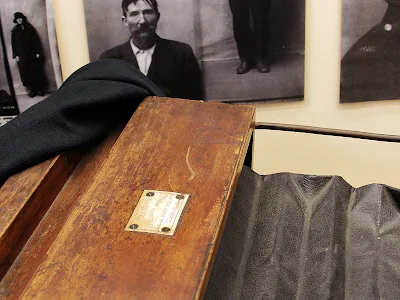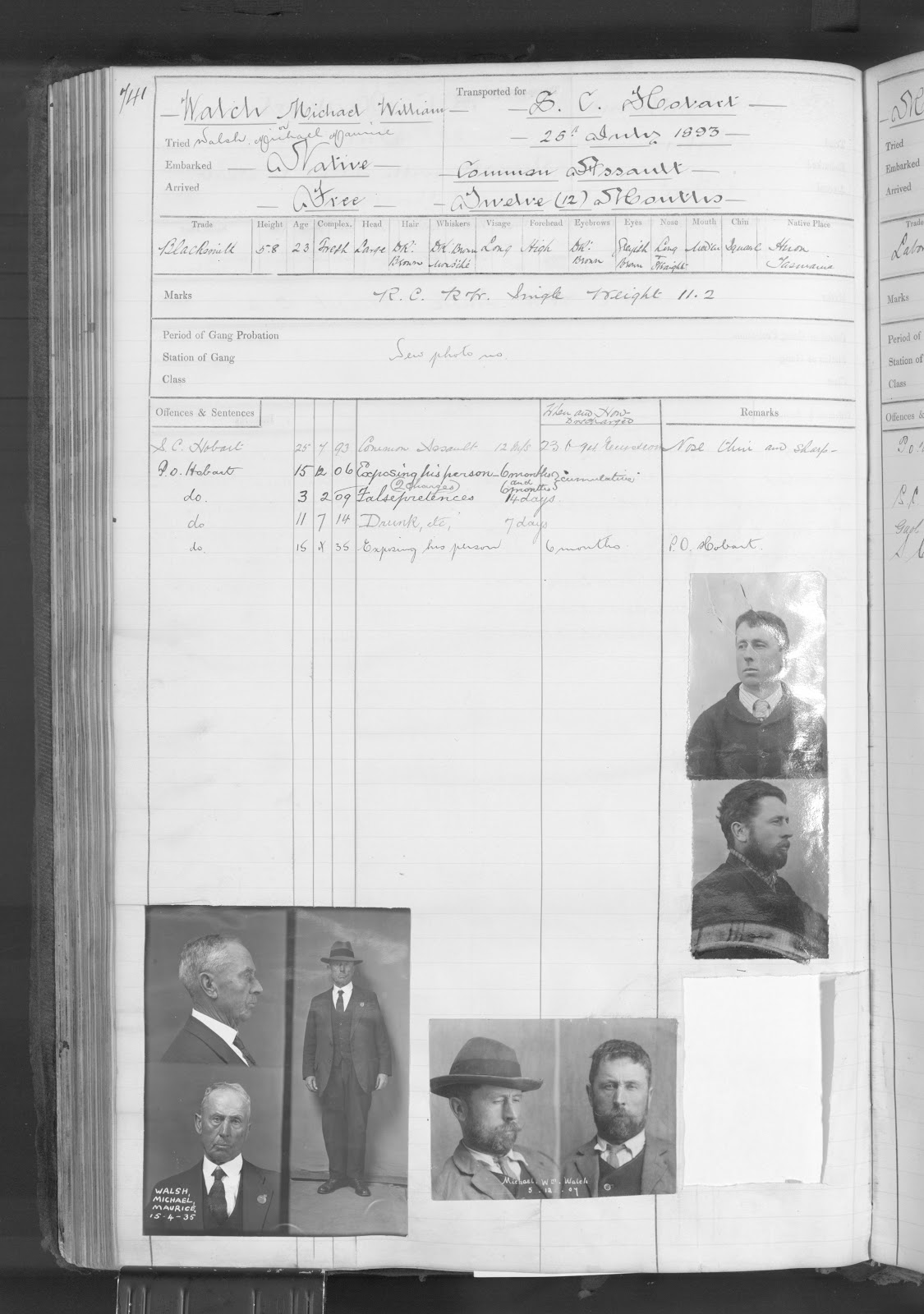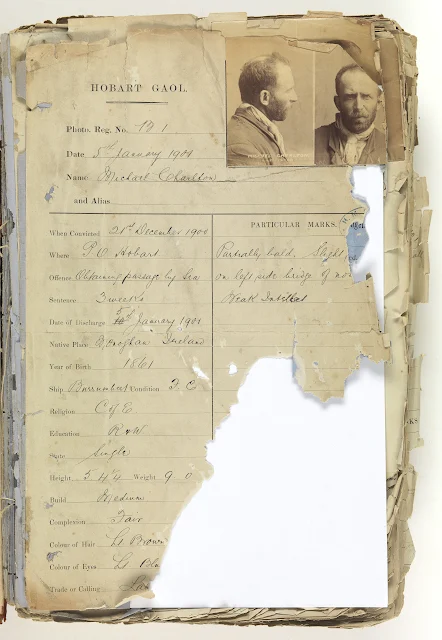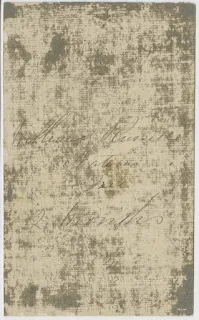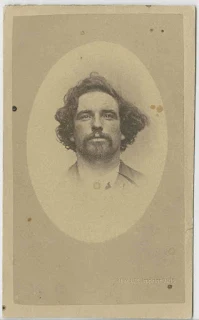The Bicentenary of the Battle of Waterloo, in which the British, led by the Duke of Wellington defeated the Emperor of France, Napoleon Bonaparte (Belgium, 1815), is being celebrated in Britain this month (June 2015). View the re-enactments 18-21 June 2015 of the Battle of Waterloo 1815 at YouTube.
Mount Wellington was commonly referred to as Table Mountain by explorers to Van Diemen's Land (Tasmania) from Bligh's visit in 1791 until 1832 when Matthew Flinders renamed it after the Duke of Wellington. Under dual-naming policy, the mountain is known as kunanyi in Palawa-kani, the revived composite language of Tasmanian Aborigines.
Thomas Nevin on kunanyi/Mount Wellington
Copies of this selection of stereographs taken by Thomas J. Nevin, late 1860s, on and around the summit of kunanyi/Mount Wellington, were sourced from the Tasmanian Museum and Art Gallery Collection in 2015.

Snow on kunanyi/Mt Wellington at the "Ploughed Field"
Stereograph on buff mount
Thomas J. Nevin late 1860s
TMAG Ref: Q1994.56.16. Verso below.


A group at the Beacon Light, kunanyi/Mt. Wellington
Stereograph on buff mount
Thomas J. Nevin late 1860s
TMAG Ref: 1994.56.29. Verso below.


A large party sitting atop the Beacon Light, kunanyi/Mt. Wellington
Stereograph on buff mount
Thomas J. Nevin late 1860s
TMAG Ref: Q16826.7. Verso below.
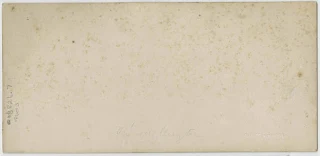

A group at the Rocking Stone, kunanyi/Wellington.
Stereograph on buff mount
Thomas J. Nevin late 1860s
TMAG Ref: Q1994.56.4.Verso below.


Three men sitting on boulders, kunanyi/Mt. Wellington
Stereograph on buff mount
Thomas J. Nevin late 1860s
TMAG Ref: Q16826.32. Verso below.


Ferns covered in snow, kunanyi/Mt. Wellington
Stereograph on buff mount
Thomas J. Nevin late 1860s
TMAG Ref: Q16826.31.1.Verso below.

[Above] A selection of stereographs taken by Thomas J. Nevin, late 1860s, on and around the summit of kunanyi/Mount Wellington From the Tasmanian Museum and Art Gallery Collection 2015
Samuel Clifford: footsore on Mt Wellington 1865
Thomas Nevin's close friend and colleague Samuel Clifford made a photographic excursion to the Falls (Springs) half way up kunanyi/Mount Wellington on February 9th, 1865, and regretted he had not worn the appropriate foot wear. This is his note left in the Visitors' book:
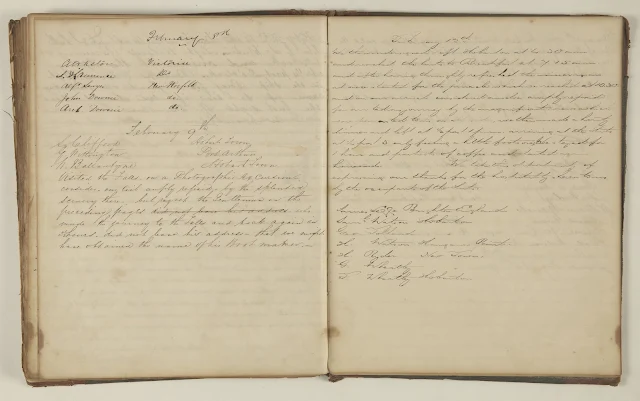
Visitors Book: kunanyi/Mount Wellington
Item Number: NS4160/1/1
Description: Vistors Book
Further Description:
Start Date: 04 Dec 1860
End Date: 31 Oct 1865
Source: Archives Office of Tasmania
TRANSCRIPT
February 9thThis is the place where the guide to the mountain Mr. Woods and his family resided and where the visitors to the Falls signed the Visitor's Book, photographed by Samuel Clifford on this visit or later, reprinted with the date ca. 1873. A photograph of Samuel Clifford on kunanyi/Mt. Wellington also survives, taken by another photographer, probably his friend and collaborator Thomas Nevin.
S. Clifford Hobart Town
G. Wittington Port Arthur
H. Ballantyne Hobart Town
Visited the Falls on a Photographic Excursion, consider our trip amply repaid by the splendid scenery but regret the Gentlemen in the preceding pages [did not leave his address = struck through] who made the journey to the Falls and back again in 2½ hours did not leave address that we might have obtained the name of his Boot maker. -
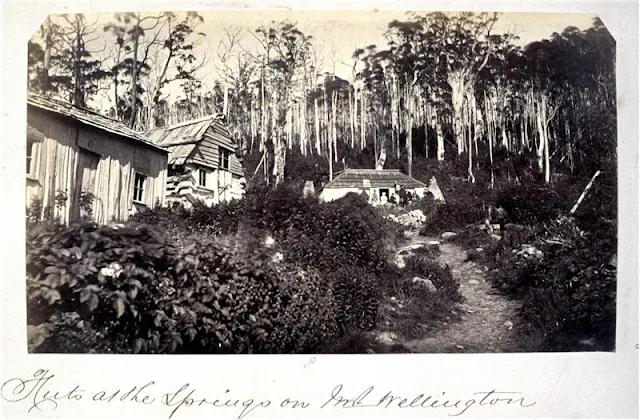
Archives Office Tasmania
Huts at the Springs on kunanyi/Mt Wellington [ca. 1873]
Physical description: 1 photograph : sepia toned ; 11 x 19 cm.
Notes: Title inscribed in ink below image ; date noted in pencil at lower right of image on album page ; item number noted in ink at centre left of image on album page.
Exact size 105 x 184 mm. "Tasmanian scenes" also known as "Clifford album 1".
A Queensland visitor's account of a trip up the mountain 1864
From the Queensland Times, Ipswich Herald and General Advertiser (Qld. : 1861 - 1908), Thursday 14 July 1864, page 4
A TRIP UP MOUNT WELLINGTON, TASMANIA. This mountain is situated in the county of Bucking-ham, Tasmania, and about six miles west of the city of Hobart Town, the highest point being 4166 feet above the level of the sea. Its appearance from the town in clear weather is most imposing, but the summit, at times, is enveloped in clouds of fog, and occasionally in the winter season capped with snow of no inconsi-derable depth. During the summer months the resi-dents in the neighbourhood make up parties of perhaps six or twelve, and starting with the sun just peeping over the eastern hills, ascend its summit, a distance in reality of about eight miles; but, owing to the very steep and difficult track to be traversed, is equal, in regard to labour, to double that distance.Source:Queensland Times, Ipswich Herald and General Advertiser (Qld. : 1861 - 1908), Thursday 14 July 1864, page 4
In winter very few venture up, it being, at times, impassable, from the depth of snow, or dangerous, on account of the uncer-tainty of fogs which, at times, come over so suddenly that a person could not, on such an occasion, without great risk of slipping between the rocks, or losing his way, descend its rugged sides in safety. Our party, consisting of three, being on a visit to the colony, having spent two days in the quiet city of Hobart Town, admiring the delightful scenery around and the magnificent river on which it is built, resolved to spend a day on the mount. Making inquiries, we were rather discouraged by being informed that it was very imprudent at this time of year (the month of May) to attempt it, for the reasons just mentioned, our in-formants relating to our astonished ears accounts of some unfortunate having gone up and never having been seen or heard of again; or of some others who were lost for days and at last discovered in the last stage of exhaustion; then of broken limbs caused by slipping off the rocky points with which it in some parts abounds or of illness caused by drinking the nearly freezing water on its summit. All these pleasing little anecdotes made us thoughtful; we looked at the terrible hill and wondered how anything so beautiful could be dangerous. However, discrediting two-thirds of our information, and resolving to risk the other, we called our worthy host, and having made arrangements with him to prepare us a little of some-thing eatable and a small bottle of brandy each for the following morning, we sallied forth to the adjacent livery stable and ordered a dog-cart to be ready, so that we might save all the walking possible.
A tolerably clear and sunny morning followed, and each partaking of a hearty breakfast, we strapped our provisions and opera glasses at our sides, and at half past nine o'clock drove off along Macquarie-street, the only two miles of our road along which a vehicle could pass. This was soon accomplished, and descending at De Graves' (the Cascades), which is at the foot of the Mount, we started on foot. It was now a quarter to ten. After walking about a mile, the Huon road branches off to the left; we, continuing onwards and entering the dense forest through which our road lay, arrived at the first steep ascent. Our labours com-menced; upwards a little to the left, then to the right, we arrived, out of breath, on what is called thle First Level. Here we stopped a moment to rest. Onwards again, we saw before us another treat in store. Again we went rapidly upwards, but this time found it no easy task, as the track was covered with loose stones, which threatened every moment to introduce the nose to some geological specimen. A quarter of an hour of this laborious exercise, without the slightest prospect of another "level," suggested the propriety of a halt for a few moments, and upwards again, winding right and left, and jumping over fallen trees which lay across our path, until at last we found a second but very short level. Here another moment's stay, and then a fresh ascent of some difficulty, till, after a great many slips and jumps, and several halts, we at last emerged from the dense mass of noble trees through which we had passed, and came upon the "Huts," at The Springs, three in number, each guarded by a small but very noisy dog, under chain, the dumb trio welcoming us with no small amount of barking and straining to get at us. Entering the best of the three, we were accom-modated with seats before resuming our journey. The hut we were in was built of logs, containing but one apartment, in which lived a man, his wife (who was ill in bed at this time), children, and a woman acting as nurse. We were informed afterwards that this man receives a small remuneration from Government for his services, rendered if necessary to any one who should go past his abode, but who not returning by nightfall need assistance to find his way back. Here, too, the late visitor in returning may sleep, the room being divided on such an occasion by a screen.
These huts are situated about half-way between the Cascades and the mountain top, and from here a limited but beautiful view is obtained, the trees around having been to a great extent cut down. After stopping about a quarter of an hour, and ordering a meal to be ready on our return, and procuring the services of a man to accompany us as a guide, at ten minutes to twelve we again started. Our ascent now began to assume a still more rugged appearance, it being steep, rough, and wet, and requiring a deal of exertion to ascend it with-out falling. A quarter of an hour brought us to the first ice-house, a log building not now in use, built to preserve ice gathered from the mountain for Govern-ment use. Passing this we came upon fresh difficulties; it was now climbing over dead logs, and pushing through dead brushwood, which lay thickly covering the rugged and slippery track. After passing the new ice-house, and scrambling upwards for about half-an-hour, we halted at the upper ice-house, or rather the charred and roofless remains of a rude building for-merly used as such. Lighting our pipes we enjoyed a seat on the stones, our legs beginning to feel the effects of the up-hill work we had been doing. Soon beginning to get very cold, however, we made another start, leaving the ruins and the very ex-tensive view seen from here behind us, and taking a path at right angles to the one we had just pursued, pushing our way through and amongst the weather-leached dead scerubs and logs, which here lay thick and troublesome, we at last came up to the Ploughed Field. This is the most difficult and dangerous part of the ascent, it being an extensive plain of huge masses of rock heaped one on the other in wild confusion, between some of which there are crevices of from four to ten feet in depth, a fall down any of which, without assistance at hand, would be dangerous in the extreme, as it would be impossible to get out again even sup-posing you escaped with a whole skin. The greatest caution is, therefore, necessary in crossing this "field;" from here to the summit there is no track to follow, the wind blows with great force and the temperature is extremely cold; all vegetation ceases, nothing to is seen but barren rocks. Tying out hats on we commenced like so many frogs to leap from rock to rock, now balancing on one of a very uneven and slippery surface, next leaping off again, after being nearly blown backwards by a sudden gust of chilling wind, and then a halt for breath or to obtain something like a perpendicular before another leap, varying the performances by scrambling over one, or climbing up or slipping down another. Labor omnia vincit.
After about twenty-five minutes severe exercise, with red noses and burning ears, we reached the opposite side of this novel field, where the unpleasant-looking crevices were supplied with the more safe substitutes of soil. Again climbing over a few upright and slippery rocks, little streams of water trickling down their sides and forming miniature lagoons at their base-we came upon the "Plains." Our guide informed us that there is plenty of kangaroo hunting about these plains in the summer time; also, that by crossing to the right we should arrive at the Giant's Grave-two perpendicular rocks supporting another horizontally, and near to which the Rocking Stone, a huge egg-shaped rock, so nicely balanced that one person can rock it to and fro. But we, preferring to lose no time in arriving at the summit, went across towards the Pinnacle, at which, after walking about a mile and a half amongst the rocks, we arrived at half-past one o'clock, having been exactly three hours and fifty minutes from where we left the dog-cart at De Graves'. The Pinnacle is a square structure built by Government on this, the highest point of the mountain, of logs of wood laid one over the other, horizontally, about fourteen feet in height and seven or eight through, the centre being filled up with stones. Taking a seat to leeward of this building, so as to escape the severity of the wind, we turned our attention to the magnificent view and vast extent of country before us. Below lay Hobart Town, more resembling in appearance a beautiful model than a real city, so small appeared the numerous buildings, streets, wharves, and vessels in and around it; beyond, on the banks of the Derwent, the Domain, Botanical Gardens, and Government House, and Newtown; following the course of the river to he northward, the bridge crossing it at Bridgewater (the main road through to Launceston), and on the other side the Dromedary, a mount in the neighbourhood of Bridgewater about 3245 feet in height-the several ranges in the counties of Monmouth, Somerset, and Glamorgan: and (we were informed), in clear weather, the Ben Lomond Ranges in the county of Cornwall are plainly visible, the highest point of which is 5019 feet above the sea, and is distant in a straight line from Mount Wellington about ninety miles. Again, in the distance to the east-ward, Pitt Water, Storm Bay, Norfolk Bay, the hills on Tasman's Peninsular, and others in the country of Pembroke, and a small portion of the blue waters of the Pacific; to the southward Cape Direction and the entrance to the Derwent, and the hills of North Bruni and South Bruni, the mouth of the Huon River, and the high ranges in the county of Kent, the highest point of which (Mount Picton) is 4340 feet. This prospect is grand beyond description-its magnificence must be witnessed to be thoroughly appreciated.
Changing our position to the other side of the Pinnacle, and looking westward, we found the view nearly hidden by the rugged rocks on the west side of this mount, and Collins' Bonnet, an adjacent hill of considerable height, all that was visible being the blue tops of the ranges on the west border of the county of Buckingham, the highest point of which is 4721 feet above the sea. Again turning to the north, and peering through our glasses at the many tiny farms and homesteads scattered far and wide, with their little patches of cultivated land around them, and Far to the south and east, where lay, Extended in succession gay, Deep waving fields and pastures green, With gentle slopes and groves between; and tracing out on the natural chart before us the nu-merous roads and townships, we thought of retracing our steps downwards, our guide considering it prudent to get across the Ploughed Field in case a fog should overtake us before we could get on the other side. So taking a last look around and feeling well rewarded for the exertions undertaken, we rose from our rocky seats and started at about half-past 2 o'clock across the Plains, feeling exceedingly stiff about the legs, and un-comfortably cold about the nose, ears, and finger ends. Arrived at the Ploughed Field we sat down behind the rocks out of the wind to refresh ourselves with sand-wich, brandy, and water-the latter obtained from among the crags around us. Feeling warmer, with much labour and difficulty, we crossed the field, finding it, strange to say, much more laborious than when we were going up. Passing the dilapidated ice-house we soon began rapidly to descend, now more pleasant, having got out of the severity of the wind to which we had been exposed-down, down, every yard increasing our fatigue, passing the lower ice-house at twenty-five minutes to 4; and again another tiring descent, we arrived at the huts at the Springs about 4 o'clock, gladly resting our weary limbs and aching legs for a while before proceeding. Our meal was ready, consist-ing of steaks, potatoes, bread, and tea, minus milk, a superfluous article on the mountain. It is needless to explain the relish with which we all three did full jus-tice to the viands thus set before us on a rude but clean table of home manufacture. It was evident that no trouble had been spared by the host during our absence in doing all in his power to make us comfortable. At his request we wrote a short account of our trip in a book, kept by him for that purpose, stating times of starting, arriving, and returning, with our names, &c., for the information of others in future.
After a stay of forty minutes, and remunerating our guide, we re-sumed our downward journey, entering the labyrinth of trees again, and dragging our now weary limbs down the very steep and slippery descents, occasionally vary-ing the amusements by scrambling over a fallen tree, or having to take a circuitous way round a similar ob-struction of too large dimensions to get over. Soon the sun's expiring rays between the trees disappeared, and approaching darkness began rapidly to surround us. Down, still down we went, till a quarter to 6, when we passed the Huon Road, and skirting Fern Tree Gully in the darkness (which lay deep and quiet on our left hand), we came upon the lights of the city. Refreshing ourselves, we took our seats, and were soon rattling along Macquarie-astreot, arriving at our hotel at half-past 6 o'clock, having been exactly nine hours ac-complishing this most gratifying excursion. By a blazing fire, stretched out in easy chairs in the coffee-room, our boots replaced by slippers, and a soothing cloud of tobacco smoke ever and anon above our heads, we all came to the conclusion that, regard-less of the labour (which we then admitted to be trifling) necessary to its accomplishment, all is repaid by the magnificent view obtained on "a trip up Mount Wellington. J. G. H.
kunanyi/Mount Wellington with the Derwent Entertainment Centre foreground, taken from the River Derwent.
Photo copyright © KLW NFC Imprint 2015 ARR.



